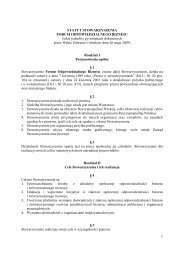Electric Vehicles in the United States - Coleman Fung Institute for ...
Electric Vehicles in the United States - Coleman Fung Institute for ...
Electric Vehicles in the United States - Coleman Fung Institute for ...
- No tags were found...
You also want an ePaper? Increase the reach of your titles
YUMPU automatically turns print PDFs into web optimized ePapers that Google loves.
University of Cali<strong>for</strong>nia, BerkeleyCenter <strong>for</strong> Entrepreneurship & TechnologySummary of F<strong>in</strong>d<strong>in</strong>gsThis paper was commissioned by <strong>the</strong> Center <strong>for</strong> Entrepreneurship and Technology at <strong>the</strong> University ofCali<strong>for</strong>nia, Berkeley. It estimates <strong>the</strong> rate of market adoption of electric vehicles <strong>in</strong> <strong>the</strong> <strong>United</strong> <strong>States</strong>through 2030 and analyzes <strong>the</strong> impact of electric car deployment on <strong>the</strong> trade balance, bus<strong>in</strong>ess <strong>in</strong>vestment,employment, health care costs, and greenhouse gas emissions. The market adoption analysis usesa network externalities model that accounts <strong>for</strong> <strong>the</strong> purchase price and operat<strong>in</strong>g costs of electric vehiclesus<strong>in</strong>g switchable batteries and charg<strong>in</strong>g networks …nanced by pay-per-mile contracts.The market penetration rate of electric cars and <strong>the</strong> accompany<strong>in</strong>g estimates of macro-economicimpacts are a function of world oil prices and <strong>the</strong> relative purchase price of drivetra<strong>in</strong>s. This paper<strong>for</strong>ecasts three electric vehicle adoption scenarios based on two oil price scenarios and possible purchaseprice <strong>in</strong>centives <strong>for</strong> electric cars. The follow<strong>in</strong>g summarizes <strong>the</strong> ma<strong>in</strong> …nd<strong>in</strong>gs of <strong>the</strong> paper: ELECTRIC CAR SALES: In <strong>the</strong> basel<strong>in</strong>e <strong>for</strong>ecast electric cars account <strong>for</strong> 64% of U.S. light-vehiclesales by 2030 and comprise 24% of <strong>the</strong> U.S. light-vehicle ‡eet. The rates of adoption are driven by<strong>the</strong> low purchase price and operat<strong>in</strong>g costs of electric cars with separate battery ownership or batteryleas<strong>in</strong>g. The estimates <strong>in</strong>clude <strong>the</strong> cost of <strong>in</strong>stall<strong>in</strong>g charg<strong>in</strong>g and battery switch<strong>in</strong>g <strong>in</strong>frastructureto extend <strong>the</strong> range of electric vehicles. LOWER OIL IMPORTS: U.S oil imports <strong>in</strong> 2030 under <strong>the</strong> electric vehicle deployment scenariosare projected to be 18-38% lower than <strong>the</strong> scenario of improved <strong>in</strong>ternal combustion eng<strong>in</strong>e fuele¢ ciency, equivalent to 2.0-3.7 million barrels per day. For reference, <strong>the</strong> <strong>United</strong> <strong>States</strong> <strong>in</strong> 2008imported 2.3 million barrels per day from <strong>the</strong> Persian Gulf. IMPROVED TRADE DEFICIT: The U.S. imported $400 billion of petroleum <strong>in</strong> 2008, which accounted<strong>for</strong> 59% of <strong>the</strong> trade de…cit. This paper estimates that electric car adoption lowers <strong>the</strong>annual trade de…cit by between $94 and $266 billion by 2030 over a scenario of improved <strong>in</strong>ternalcombustion eng<strong>in</strong>e fuel e¢ ciency. NEW SOURCES OF INVESTMENT: Bus<strong>in</strong>ess <strong>in</strong>vestment <strong>in</strong> a domestic battery manufactur<strong>in</strong>g<strong>in</strong>dustry and <strong>the</strong> deployment of charg<strong>in</strong>g <strong>in</strong>frastructure grows to account <strong>for</strong> between 1.1% and 1.5%of total U.S. bus<strong>in</strong>ess <strong>in</strong>vestment by 2030. With additional <strong>in</strong>vestment <strong>in</strong> battery manufactur<strong>in</strong>g,<strong>the</strong> <strong>United</strong> <strong>States</strong> has <strong>the</strong> potential to become an exporter of automotive batteries. HIGHER OVERALL EMPLOYMENT: There is a net employment ga<strong>in</strong> of between 130,000 and350,000 jobs by 2030. New jobs are created <strong>in</strong> <strong>the</strong> battery manufactur<strong>in</strong>g <strong>in</strong>dustry and <strong>in</strong> <strong>the</strong>construction, operation, and ma<strong>in</strong>tenance of a domestic charg<strong>in</strong>g <strong>in</strong>frastructure network. The jobga<strong>in</strong>s outweigh modeled job losses among gas station attendants, mechanics, and parts <strong>in</strong>dustrymanufacturers. HEALTH CARE COST SAVINGS: Health care cost sav<strong>in</strong>gs stem from lower emissions of airbornepollutants. The net present value of <strong>the</strong> health impact of electric vehicle deployment to 2030 isbetween $105 and $210 billion when vehicles are charged us<strong>in</strong>g non-pollut<strong>in</strong>g sources of electricity.Health care cost sav<strong>in</strong>gs rema<strong>in</strong> positive when electric vehicles are charged us<strong>in</strong>g <strong>the</strong> currentelectricity grid.CET Technical Brief<strong>Electric</strong> <strong>Vehicles</strong> <strong>in</strong> <strong>the</strong> <strong>United</strong> <strong>States</strong>
















